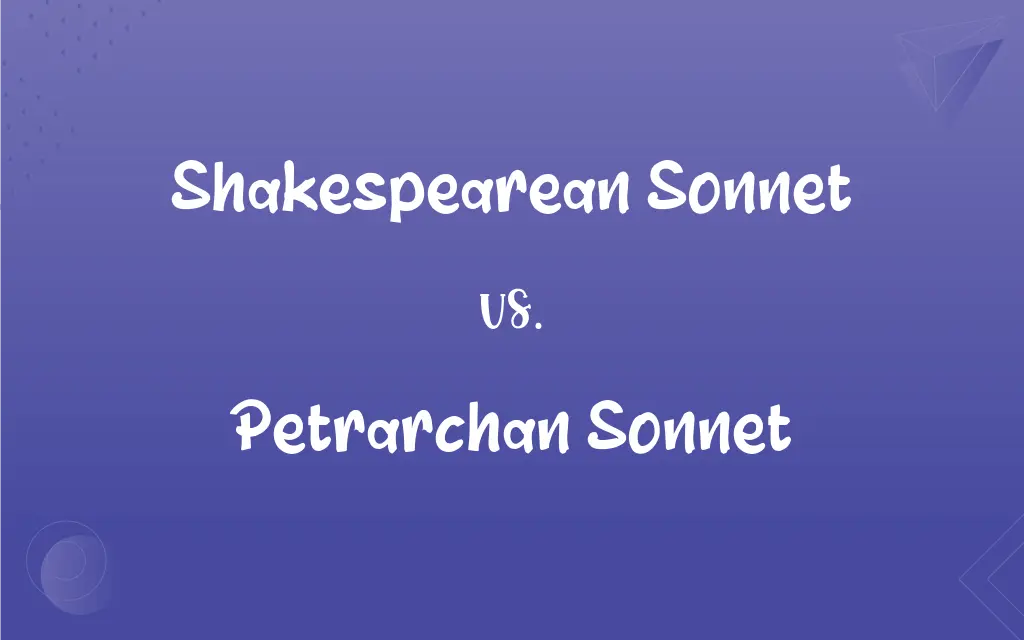Shakespearean Sonnet vs. Petrarchan Sonnet: What's the Difference?
Edited by Aimie Carlson || By Harlon Moss || Published on March 6, 2024
Shakespearean sonnets consist of three quatrains and a couplet, typically exploring themes variably, whereas Petrarchan sonnets are divided into an octave and a sestet, often featuring a problem-solution structure.

Key Differences
Shakespearean sonnets are known for their structure of 14 lines, divided into three quatrains followed by a final rhyming couplet. This structure allows for a flexible exploration of themes, with each quatrain potentially presenting a new aspect or argument, culminating in a conclusive insight in the couplet. Petrarchan sonnets, in contrast, split the 14 lines into an octave and a sestet, traditionally using the octave to pose a problem, question, or theme, and the sestet to provide a resolution or commentary, creating a clear demarcation in content and form.
The rhyme scheme in Shakespearean sonnets (ABAB CDCD EFEF GG) facilitates English phonetics, providing a wide range of rhyming options. This scheme supports a variety of themes, from love to mortality, allowing for nuanced storytelling within the poetic form. Petrarchan sonnets follow a stricter rhyme scheme (ABBAABBA CDCDCD or CDECDE), which can be more challenging to adhere to in English due to its limited rhyming words, often leading to a more focused and intense exploration of themes, particularly those of love and nature.
Shakespearean sonnets often use the final couplet as a twist or a conclusion that reflects on the preceding quatrains, providing a sharp closure or unexpected insight. This element of surprise or summation gives the Shakespearean form a dynamic and narrative quality. The Petrarchan sonnet's sestet, however, serves to answer or counterbalance the octave, requiring a nuanced shift in tone or perspective, which demands a more integrated approach to the poem's theme and structure.
The thematic flexibility of Shakespearean sonnets allows for a broad exploration of human experience, utilizing the form to examine individual emotions, societal norms, or philosophical questions in a reflective manner. Petrarchan sonnets, with their two-part structure, lend themselves well to the exploration of dichotomies, such as idealized love versus reality, encouraging a deeper introspection within a more confined framework.
The cultural origins of these sonnet forms reflect their usage and thematic concerns. Shakespearean sonnets, rooted in English literature, often reflect the complexities of human nature and societal issues, mirroring the Elizabethan era's concerns. Petrarchan sonnets, originating from Italy and refined by Petrarch, are imbued with the ideals of the Renaissance, focusing on personal emotion, nature, and the pursuit of beauty, illustrating the form's adaptability across different languages and literary traditions.
ADVERTISEMENT
Comparison Chart
Structure
3 quatrains and 1 couplet
1 octave and 1 sestet
Rhyme Scheme
ABAB CDCD EFEF GG
ABBAABBA CDCDCD/CDECDE
Theme Exploration
Varied, with a flexible approach
Often a clear problem-solution structure
Final Lines
Conclusive couplet offering insight or twist
Sestet provides resolution or counterargument
Cultural Origins
English, reflecting societal and individual themes
Italian, focusing on personal emotion and nature
ADVERTISEMENT
Shakespearean Sonnet and Petrarchan Sonnet Definitions
Shakespearean Sonnet
A poetic form with three quatrains and a concluding couplet, often exploring complex themes.
In his sonnet, Shakespeare ponders the nature of time and love.
Petrarchan Sonnet
The octave introduces a problem or theme, while the sestet offers resolution.
In the octave, he laid out his dilemma, which the sestet artfully resolved.
Shakespearean Sonnet
Allows for narrative progression and thematic flexibility within 14 lines.
Through the quatrains, she developed her theme, concluding with a poignant couplet.
Petrarchan Sonnet
Follows a strict rhyme scheme of ABBAABBA with a variable sestet pattern.
Adhering to the Petrarchan scheme, her sonnet beautifully captured the essence of longing.
Shakespearean Sonnet
Often concludes with a couplet that provides a resolution or a twist.
The final couplet of the sonnet offered an unexpected insight into the poet's thoughts.
Petrarchan Sonnet
Emphasizes a shift in tone or argument between the octave and sestet.
The transition from octave to sestet marked a profound shift in the speaker's perspective.
Shakespearean Sonnet
Reflects the intricacies of human emotions and experiences.
His sonnet delved into the complexities of human desire and regret.
Petrarchan Sonnet
Divided into an octave and a sestet, traditionally exploring themes of love or moral questions.
The Petrarchan sonnet expressed an unattainable love, vivid in its longing.
Shakespearean Sonnet
Characterized by a rhyme scheme of ABAB CDCD EFEF GG.
The poet adhered to the Shakespearean rhyme scheme, crafting a sonnet that mirrored classical form.
Petrarchan Sonnet
Known for its use in exploring idealized love and philosophical queries.
Her Petrarchan sonnet pondered the nature of beauty, engaging in a deep philosophical inquiry.
FAQs
What is the significance of the rhyme scheme in Petrarchan sonnets?
The strict rhyme scheme of Petrarchan sonnets (ABBAABBA CDCDCD/CDECDE) emphasizes the form's elegance and the poet's skill in weaving complex themes within a structured pattern.
Can the themes of Shakespearean sonnets vary, and how?
Yes, Shakespearean sonnets can explore a wide range of themes, from love to morality, allowing each quatrain to present different facets of the central theme, culminating in a reflective couplet.
Can the rhyme scheme of a Petrarchan sonnet vary within the sestet?
CDCDCD or CDECDE), allowing for some flexibility in how the resolution or counterargument is structured.
What is the main structural difference between a Shakespearean and Petrarchan sonnet?
The main structural difference is that a Shakespearean sonnet is composed of three quatrains followed by a couplet, whereas a Petrarchan sonnet is divided into an octave and a sestet.
What is a common theme explored in both Shakespearean and Petrarchan sonnets?
Both forms often explore the theme of love, though they may approach it from different angles, with Petrarchan sonnets focusing on idealized love and Shakespearean sonnets exploring love's complexity.
How does the cultural origin of each sonnet form influence its themes and usage?
Shakespearean sonnets, rooted in the English literary tradition, often reflect the societal and individual concerns of the Elizabethan era, while Petrarchan sonnets, with their Italian Renaissance origins, tend to focus on idealized love, nature, and personal emotion.
Why are Petrarchan sonnets particularly suited for exploring themes of love and nature?
Their two-part structure, with an octave setting up a theme and a sestet providing resolution, mirrors the complexity and depth of emotions associated with love and the natural world, allowing for an introspective exploration.
Is it more challenging to write a Petrarchan sonnet in English? Why or why not?
Yes, it can be more challenging due to the stricter rhyme scheme, especially the ABBAABBA pattern in the octave, which may limit rhyming options in English.
How does the final couplet of a Shakespearean sonnet contribute to its overall theme?
The final couplet often provides a conclusion, twist, or deep insight, effectively summarizing the theme or presenting a new perspective on the preceding quatrains.
Can a Petrarchan sonnet's octave and sestet explore completely unrelated themes?
While they can explore different aspects of a theme, the octave and sestet are usually related, with the sestet providing a resolution, counterargument, or reflection on the octave's theme for cohesion.
Are Shakespearean sonnets restricted to themes of love?
No, Shakespearean sonnets are not restricted to love themes; they can explore a broad spectrum of human experiences, including morality, beauty, politics, and the passage of time.
Are Petrarchan sonnets always about unrequited love?
No, while unrequited love is a common theme due to Petrarch's influence, Petrarchan sonnets can also explore a wide range of subjects including moral questions, nature, and personal introspection.
How do modern poets adapt these sonnet forms?
Modern poets often experiment with these forms, sometimes blending elements of both or bending the traditional rules to explore contemporary themes, demonstrating the forms' adaptability.
How does the structure of a Shakespearean sonnet affect its narrative flow?
The structure of three quatrains followed by a couplet allows for a narrative progression, with each quatrain building upon the theme, leading to a conclusive or reflective couplet, enhancing the sonnet's storytelling aspect.
How do the final two lines of a Shakespearean sonnet differ in purpose from the sestet of a Petrarchan sonnet?
The final two lines of a Shakespearean sonnet often serve as a punchy conclusion or twist, while the sestet of a Petrarchan sonnet provides a nuanced resolution or reflection, making for a more gradual and introspective close.
Can the themes in Shakespearean sonnets be considered universal?
Yes, Shakespearean sonnets often delve into universal themes such as the nature of love, the passage of time, and human mortality, making them relatable across different ages and cultures.
How does the use of imagery differ between the two sonnet forms?
While both forms use imagery to enhance their themes, Petrarchan sonnets often employ more concentrated and elaborate imagery, especially in the octave, to intensify the emotional or thematic setup, whereas Shakespearean sonnets may use imagery more variably across the quatrains.
What role does the volta play in Petrarchan sonnets?
The volta, or turn, in Petrarchan sonnets typically occurs between the octave and sestet, marking a shift in argument, perspective, or tone, and is crucial for transitioning from the problem or theme to the resolution.
Are there any notable exceptions to the traditional forms of these sonnets?
Yes, throughout literary history, poets have occasionally deviated from the traditional forms to suit their thematic or stylistic needs, leading to variations that still resonate with the essence of the Shakespearean or Petrarchan sonnet.
How do these sonnet forms reflect the poets' linguistic creativity?
Both sonnet forms showcase the poets' linguistic creativity through their adherence to and deviations from the traditional structures and rhyme schemes, demonstrating how constraints can inspire innovative expressions of complex themes and emotions.
About Author
Written by
Harlon MossHarlon is a seasoned quality moderator and accomplished content writer for Difference Wiki. An alumnus of the prestigious University of California, he earned his degree in Computer Science. Leveraging his academic background, Harlon brings a meticulous and informed perspective to his work, ensuring content accuracy and excellence.
Edited by
Aimie CarlsonAimie Carlson, holding a master's degree in English literature, is a fervent English language enthusiast. She lends her writing talents to Difference Wiki, a prominent website that specializes in comparisons, offering readers insightful analyses that both captivate and inform.































































